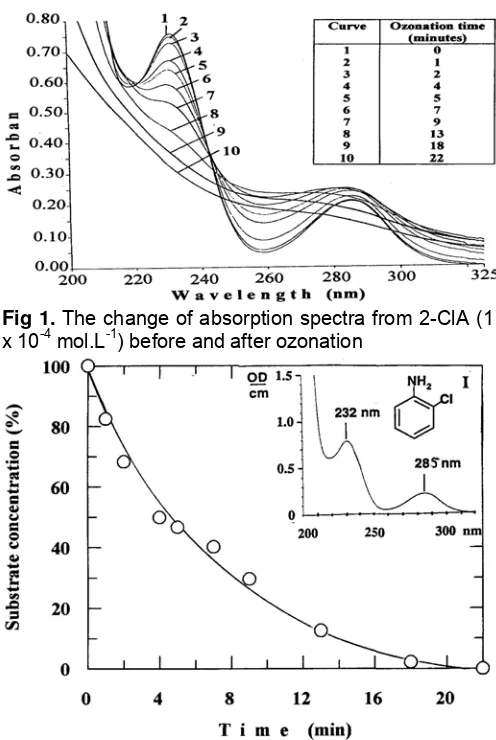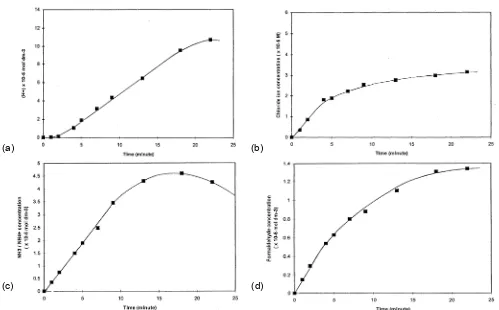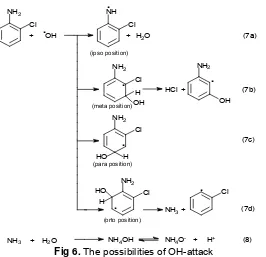Indo. J. Chem., 2007, 7 (2), 137-140 137
ORTHO
-CHLOROANILINE DEGRADATION
UNDER THE INFLUENCE OF OZONE IN AQUEOUS SOLUTION
Ermin Katrin Winarno*
Center for The Application of Isotopes and Radiation Technology, National Nuclear Energy Agency Jl. Cinere Pasar Jumat, Lebak Bulus, Jakarta Selatan, 12440
Received 16 February 2007; Accepted 14 May 2007
ABSTRACT
The degradation study on 2-chloroaniline (2-ClA) used as a model of water pollutant by ozonation was performed. The change of spectrum and substrate concentration of treated solutions were measured by spectrophotometer as well as by HPLC method. The change of solutions pH after ozonization was observed. The yields of the products formed (chloride ions, ammonium ions, and formaldehyde) were investigated as a function of ozonation time. The results showed that the ozonation gave to an efficient degradation of 2-ClA.
Keywords: degradation, ortho-chloroaniline, ozone
INTRODUCTION
The increasing chloro-organic compounds contamination in the environment is one of the biggest problems for the human future. The production and usage of various chlorine-containing pesticides, various chemicals, as well as fertilizer in modern agriculture, largely contribute to the contamination in the ground water [1]. On the other hand, advanced oxidation processes (AOP) based on various techniques have been studied mostly on laboratory scale and proposed for purification of drinking water, industrial wastewater, groundwater and landfill leachate [1-3]. Those techniques are not still efficient yet, hence the development of new and efficient methods for the radiation-induced degradation of water pollutants is necessary [3-5]. For that purpose ozonation is proposed [6-7].
Ozone is a powerful oxidizing agent and is used on a technical scale for purification of drinking water as well as wastewater [8,9]. The chemistry of ozone reactivity with various substances has been studied by several researchers [1,10,11]. Ozone (O3) may react with solutes either by direct oxidation, O3 attack on the electron rich site of the solute or by indirect reaction, OH radicals resulted from the decomposition of O3 reactions are highly selective in terms of the solutes having double bonds. However, at pH > 6, OH radicals become the predominant oxidants. Although these radicals react very rapidly with organic and inorganic solutes ( k = 108 to 1010 dm3. mol-1.s-1) [12], they are less selective to attack on the solute.
EXPERIMENTAL SECTION
Material
Ortho-chloroaniline (2-ClA) used as a model
compound in this work was purchased from Fluka AG
(high purity, > 99.5 %). All other chemicals were of p.a. quality and used as obtained. The solutions 100 mL of 1 x 10-4 mol.L 2-ClA were prepared using at least three times freshly distilled water. Ozone (6.6 x 10-2 mol.L-1 ) was flowed into the aqueous substrate solution.
Instrumentation
Ozone generator used was Ozonia AG, Type CFS-1, 3A model. The absorption band was measured with a Perkin Elmer UV-Vis spectrophotometer Lambda 16. The pH of the solution was measured with a pH meter. The concentration of undegraded 2-ClA after each irradiation was determined using HPLC Hewlett-Packard, model 1046A/1050. The electrochemical-amperometry detector and Kromasil 100-C18 column (150 mm x 4.6 mm) were used. Carboxylic acids were measured using HPLC Shimadzu, LC 7A model, uv detector and Shodex KC-811 column (300 mm x 8 mm) were used.
Procedure
Ozonation treatment of 2-ClA
The substrate solution was put into a special designed radiation vessel. Ozone was flowed into the aqueous substrate solution. Each ozonation was conducted at a gas flow rate of 1 L.min-1 O3. Ozonation time were 1, 2, 4, 5, 7, 9, 13, 18, and 22 minutes. Samples after certain treatment times were taken.
Analysis
Absorption Spectra. The result of degradation was first followed by measuring the change of the absorption spectra of 2-ClA solutions without ozone and with ozone treatment, using UV-Vis spectrophotometer. Significant changes of the spectra (depending of the pH of the solution) were observed at
Ermin Katrin Winarno
Indo. J. Chem., 2007, 7 (2), 137-140 138
λ 232 nm and 285 nm. The changes of the optical
density (OD/cm) at these wavelengths as a function of the absorbance were studied as indicator for the radiation-induced degradation of 2-ClA.
Determination of 2-ClA using HPLC. The concentration of undegraded 2-ClA after each irradiation was determined using HPLC method. The eluent was MeOH / H2O = 5 / 1 and the flow rate was 1 mL/minute.
Determination of chloride ions. The formation of chloride ions as one of the degradation products was performed following Florence method [13]. The OD/cm-values were registered at λ = 460 nm. A calibration curve was used for the determination of the yield.
Determination of ammonia. Ammonia (measured
as NH4+ ions) appeared to be one of the degradation
products. The yield was determined by means of Nessler’s reagent and the absorption was measured at λ = 410 nm [14].
Determination of formaldehyde. For this purpose the method by Nash was applied [15]. The formation of formaldehyde was measured spectrophotometricaly at 412 nm. The obtained yields were calculated based on a calibration curve.
Determination of carboxylic acids. Carboxylic acids were measured using HPLC method. The eluent was H3PO4 0.03 % and flow rate was 1 mL/min.
RESULT AND DISCUSSION
Absorption Spectra of Aqueous 2-ClA
The ClA substrate has pKa = 2.6. The pH of 2-ClA solutions used in this work were kept at pH = 6.85. Hence, the unprotonated form of the substrate was investigated in the presence of O3.
NH3
Cl Cl
NH2
+ H+ pKa = 2,6 (1) +
The absorption spectrum of 2-ClA (1 x 10-4 mol.L-1) shows two maxima at 232 nm and 285 nm (see insert I in Fig 2). Chlorinated anilines are frequently used as starting substances for chemical synthesis and appear as pollutants in the industrial wastewater. Since up to now very little known upon the degradation of this group of substances using ozonation, so 2-chloroaniline (2-ClA) was choosen as a model-substrate for this experiment. In Fig 1 it is shown that absorption of the solution decreased with the increase of ozonation time. After 13 min the absorption peak disappeared, it is suggested that a lot of 2-ClA substrates were degraded. The percentage of absorption after 13 min was decreased to 44 %, this shows that there are still other compounds as the degradation products, which have double bound conjugation. The compounds increased with rising the ozonation time.
Fig 1. The change of absorption spectra from 2-ClA (1 x 10-4 mol.L-1)before and after ozonation
Fig 2. Degradation of aqueous 1 x 10-4 mol.dm-3 2-ClA in the presence of O3 (6.6 x 10-2 mol.L-1 O3) as a function time (starting pH 6.85)
Fig 3. pH-decrease as a sequence of the ozonation of aqueous 1. 10-4 mol.L-1 2-ClA as a function of time (starting pH = 6.85)
The result of the degradation of 2-ClA using ozone are plotted in Fig 2. The concentration of
ozone was high (6.6 x 10-2 mol.dm-3), so the
degradation of 2-ClA was very fast, destruction was achieved 100 % within 22 min.
Indo. J. Chem., 2007, 7 (2), 137-140 139
+ OH
NH2
Cl
.
NH2
Cl
OH OH
Cl
NH2
OO
.
+ H2O
(OH adducts on o-, m-, and ipso position)
.
.
Carboxylic acids (6)(a) (b)
(c) (d)
(4c) (4d)
Fig 4. H+ (4a), chloride ions (4b), NH3/NH4+ (4c), and formaldehyde (4d) Formation as a sequence of the ozonation of aqueous 1 x 10-4 mol L-1 2-ClA as a function of time (starting pH = 6.85)
Fig 5. The possibilities of OH-attack on various positions of the 2-ClA molecule
During degradation for various period of time, decreasing pH of solutions was observed (Fig 3), and H+ formation can be seen in Fig 4. The starting pH 6.85 of aqueous substrate solution was decreased to 3.97 after ozonation for 22 min. It indicated that acid compound products are formed.
The observed result of chloride ions is shown in Fig 4b, then Fig 4c and 4d are shown Cl- ions, NH4+ ions and formaldehyde formation. They are taken as an indicator for substrate degradation in the presence of ozone only in the solution. After 22 minutes the ozonation of 2-ClA resulted in some products of the degradation (chloride ions 3.15 x 10-5 mol L-1, NH4+ ions 4.25 x 10-5 mol L-1, and formaldehyde 1.34 x 10-5 mol L -1
).
Based on the instability of O3 in water at room temperature can initiate reactions as follows :
The possibilities of OH-attack on various positions (o-, m-, p-, and ipso-position) of the 2-ClA molecule are illustrated as Fig 5. Based on the
observed results that chloride ions, NH4+ ions and
formaldehyde are formed, the possibility of OH-attack can be explained as Fig 6.
Indo. J. Chem., 2007, 7 (2), 137-140
Fig 6. The possibilities of OH-attack
In the presence of O3, the substrate can form ozonides which is easily decomposed to form aldehydes [3] :
The muccon aldehyde as well as the mucconic acid can undergo further reaction with ozone resulting in carboxylic acids. The oxidizing species HO2• / O2• - can attack the substrate forming adducts in similar manner as the OH radicals (see eq. 7a-7d). Furthermore, a number of carboxylic acids (oxalic acid), aldehydes (formaldehyde), etc. can be formed.
CONCLUSION
Based on the results obtained, it can be concluded that the ozonation can decompose 2-chloroaniline quickly. The ozonation after 22 minutes gave the degradation of 2-ClA 100 % (6.6 x 10-2 mol dm-3 O3). Degradation of 2-ClA in aqueous solution using ozonation produced H+ ions, chloride ions, NH4+ ions, formaldehyde and oxalic acid.
ACKNOWLEDGEMENTS
The author greatly appreciates the financial support given by IAEA, Vienna, Austria that made it possible to perform this work. Thanks are also expressed to Professor Nikola Getoff for his guidance, Mr. Horst Wolfgner and Dr. K. Krapfenbauer for their help and introduction to various analytical methods.
REFERENCES
1. Getoff, N., 1993, Proceed. Indian Acad. Sci.
(Chem. Sci.), 105, 373-391.
2. Getoff, N., 1997, Peroxyl radicals in the treatment of waste solutions, in : “Peroxyl Radicals”, ed. Z. B. ALFASSI, John Wiley&Sons Ltd., G. B., 483-506 3. Balcioglu, I. A. and Getoff, N., 1998, Chemosphere,
36, 1993-2005.
4. Cooper, W.J., NIikelsen, M.G., Meacham, D.E.,
and Cadavid, E.M., 1992, Environ. Sci. Health,
127, 219-244.
8. Masschelin, W. J. (ed), 1982, Ozonation Manual for
Water and Wastewater Treatment, John Wiley &
Sons, Chichester, England.
9. Rice, R.G. and Netzer, A. (eds), 1984, Handbook
of Ozone Technology and Application, Kluwer,
Dordrecht.
10. Sehested, K., Holman, J. and Hoigne, J., 1984, J.
Phys. Chem.., 88, 5999.
11. Sehested, K., Cornfitzen, H., Holman, J., Ficsher, C.H. and Hart, E.J., 1991, Environ. Sci. Technol. 25, 1589.
12. Buxton, G.V., Greenstock, C.L., Helman, W.P. and
Ross, A.B., 1988, Phys. Chem. Refer. Data, 17,
513.
13. Florence, T. M. and Farror, Y.T., 1971, Analyt.
Chem. Acta, 54, 373-377.
14. Charlot, G., 1964, Colorimetric Determination of
Elements-Principles and Methods, Amsterdam,


